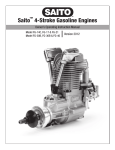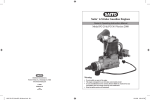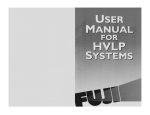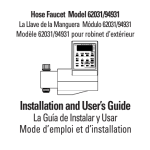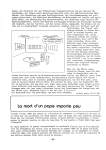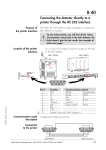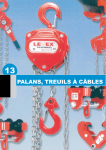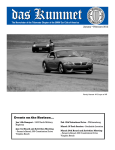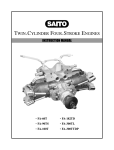Download Saito FA-30S (H) Instruction manual
Transcript
INLINE 4-STROKE ENGINES INSTRUCTION MANUAL FA-100Ti FA-200Ti 2 Important Before you attempt to operate your [200Ti/100Ti] engine, please be sure to read through these instructions so that you may familiarize yourself with the various parts and other features of the engine. Failure to read and follow these instructions before you proceed to start your engine may result in engine damage and the voiding of your warranty. Caution Be sure to read the information contained in "Safety Instructions" 3 Introduction Congratulations on purchasing a SaitoTM 4-stroke engine. When cared for properly, these high-quality, finely crafted engines offer many years of modeling enjoyment. This instruction manual has been developed to ensure optimum performance from the Saito engine you purchased. The instructions must be read through completely and understood thoroughly prior to mounting and running the engine. Recommendations ● ● ● Safety Instructions This model engine will give you considerable pleasure, satisfaction, and performance if you strictly follow these safety instructions and take heed of the warnings as to its safe and proper use. Remember at all times it is not a toy but a precision-built machine with more than enough power to cause harm if misused or if the safety precautions are not observed. 1. Mount the engine securely in a "bench mount" or high-quality motor mount. Never clamp the engine in a vise. 2. When running the engine, be sure all spectators, especially children, are at least 20 feet away. 3. Refer to the Propeller section on page 5 for the correct size and pitch of propeller for your engine. 4. It is extremely important to balance the propeller prior to installation of the engine. Failure to do so may cause damage to the Saito engine and/or the airframe. Install the propeller with the convex (curved) side facing forward. 5. Securety tighten the propeller nut against the washer and propeller. An anti-loosening nut (or"jam" nut) is provided with this engine and should be used. 6. Inspect the tightness of the propeller nut prior to each flight. 7. Keep away from the path of the propeller blades when starting and running your engine. 8. Never allow your hands to come close to the propeller. Utilize either a "chicken stick" or electric starter to start the engine. 9. Discard any propeller that is nicked, scratched, cracked or damaged in any way. 10. Make all carburetor adjustments from behind the propeller. 11. To stop the engine, cut off the fuel supply (pinch or disconnect the fuel line to the carburetor) or use the throttle linkage to shut off the fuel. Do not use hands, fingers, or any other part of the body to stop the propeller. Do not throw any object into a propeller to stop it. ● ● Safety glasses or goggles be used when starting and running your engine. Do not run the engine in the vicinity of loose gravel or sand. The propeller may throw such materials into your face and eyes. The engine may also ingest these harmful materials. Loose clothing should be avoided when operating your model engine. Clothing may become entangled in the propeller, creating the possibility of bodily harm. Also, all loose objects (screwdrivers, pencils, nickel cadmium starters, etc.) should be removed from your pockets so that they do not fall into the propeller. Keep glow plug clips and cords away from the propeller. Be sure glow fuel is kept in a safe place well away from sparks, heat, or anything that can ignite the fuel. Beware ● ● ● Model engines get very hot while running. Do not attempt to handle them until they have cooled. Always run your model engines in a wellventilated area. Similar to automotive engines, model engines produce possible harmful carbon monoxide fumes. Remember that model engines produce a substantial amount of power, more than enough to seriously injure people and/or do considerable damage to property. Always use common sense, skill, and constant observation of safety precautions. Disassembly Do not disassemble your Saito FA-200Ti/100Ti engine. Only qualified individuals should perform repairs on your FA200Ti/100Ti engine. Damage due to improper disassembly will not be covered under warranty. If it becomes necessary to repair the engine, such as after a crash, you can send your engine to the authorized service center at Horizon Hobby, Inc. Attention: Saito Service 4105 Fieldstone Road Champaign, IL 61822 Phone:(217)355-9511 4 Mounting the Engine Sturdy engine mounting is required. Mounting beams should be integral to the airframe and should provide sufficient support as necessary to absorb vibration. A beam style motor mount (SAI200Ti/100Ti-95) is provided with the FA-200Ti/100Ti to ease mounting the engine to the firewall. Engine installation should be made so that periodic maintenance can be performed easily, to include the checking and adjustment of valve clearances. 1. Screw the left muffler (200Ti-73 front) into the exhaust port of the front cylinder until it reaches the bottom, then unscrew slightly until the muffler is at the right exhaust outlet angle. Secure the muffler in position by tightening the muffler nut firmly against the cylinder head with the 12mm wrench supplied. 2. Repeat the above procedure to mount the other muffler (200Ti-74A rear, w/pressure nipple) into the rear engine cylinder. Cooling Caution: If the engine is to be mounted in an enclosed cowl, it is essential that provision be made to provide adequate cooling of both cylinders, especially the rear cylinder. This may be done through the use of baffles in the cowling to direct airflow past the cylinders. Suggestions (1) If the model uses the water-cooled type engine cowling (P-51 for example) with dummy exhaust ports in the cowling, a hole or holes can be provided in the dummy exhaust port to make sure air from the propeller can pass through the cowl and out these holes. (2) With air-cooled type engines (the Tiger Moth for example), an opening should be made under the cowling located in front of the firewall so air can pass through the cowl around the engine and outside. Mufflers installed on the engine In both cases, efforts must be taken to make sure the air passes through the cowl and around the engine and exits the engine compartment. One method is to make baffles that direct air around the cylinders and out the engine compartment. Muffler Assembly The Saito FA-200Ti/100Ti comes with exhaust pipes. These are adequate for most applications: however, many modelers will prefer to use the optional flexible exhaust pipes for many scale applications. Use the following procedure to install each muffler to the engine.(FA-200Ti is used as example) For the FA-200Ti, SAI182TD-111-1 and SAI182TD-111- 2 are the Part Numbers For the FA-100Ti, the flexible exhaust pipe is SAI100Ti111-1 and SAI100Ti.111-2(w/Pressure Fitting) Flex mufflers mounted Note:Mufflers shown are for comparison purposes only. 5 Carburetor Fuel The carburetor is located on the right side of the engine as shown in the photo below. The FA-200Ti/100Ti does not utilize a choke device, as the engine draw is sufficient for priming by putting your fingers over the muffler exhaust openings and turning the propeller over several times (without the glow driver(s) attached). For maximum protection and longevity of Saito engines, Saito recommends a high-quality fuel containing 10-15% nitro methane, such as Hangar 9® Aero-Blend, Omega. Cool Power, Power Master, etc. Use of fuels composed entirely of castor oil is not recommended. A mix of synthetic-castor oil is acceptable and can be found in the various fuels described above. Glow Plug A Hangar 9® (HAN3011) Four-Cycle Super plug is fitted to the engine. Saito recommends use of 4-stroke plugs that are designed to operate in 4-stroke engines. Since the ignition of the fuel takes place at every fourth stroke of the piston instead of every second stroke (2stroke engines) some 2-stroke plugs will not operate well in this engine. Propeller Right side of engine with close-up of carburetor A. Intake manifold body B. Intake manifold (left/right) C. Intake manifold nuts(2) D. Idle needle valve E. Throttle lever F. Carburetor mounting screws(2) Fuel Tank The suggested fuel tank size is 18/14(200Ti/100Ti) ounces. This should give approximately 10-12 minutes of running time for normal flights. The location of the fuel tank should be positioned so the centerline of the tank is below the centerline of the carburetor. Caution:Propellers should be balanced prior to use. The FA-200Ti/100Ti turns an APC 16x8"/14x6"Propeller at 9,600 (9,300) rpm using 15% glow fuel with a castor/synthetic mix. Power range of the FA-200Ti is in the FA-180 (FA-80) range. We recommend an APC 16x8" (14x6") for beak in. For safety reasons, keep away from the propeller when starting the engine or adjusting the needle valve when the engine is running. 6 Starting the Engine Caution: There is always the possibility of the propeller flying off if the propeller nut loosens due to detonation or "kick-back" when the engine is run too lean or is under a heavy load. This is especially true of four-stroke engines and can be very hazardous. Saito has provided a prop nut/antiloosing nut with the engine and they should be used to prevent the propeller from flying off, even if the propeller should loosen. 1. The propeller center hole should be reamed to the propeller diameter. Be sure the propeller is balanced. 2. Mount the propeller to the crankshaft. 3. Fit the propeller washer and nut to the propeller and screw them onto the crankshaft. Tighten securely with the wrench provided. 4. Thread the anti-loosening nut onto the crankshaft. Tighten firmly (but excessive force is not necessary) with the wrench provided. 6. Fill the Fuel tank. 7. Prime the engine. a. Check to make sure the glow plugs are not connected to the heat source (glow plug clip/locking socket). b. Open throttle fully. c. Rotate the propeller in a counter-clockwise direction 2-3 times while plugging the ends of the mufflers with your fingers so as to draw fuel into the carburetor. Electric Start Note: When using an electric starter (12V), care should be taken to be sure the engine does not become "hydro-locked" (flooded with fuel). While the electric starter will turn the engine over, it may damage the connecting rod or other components, If the engine becomes hydro-locked, simply remove the glow plug(s) and turn the engine over a few times (without glow driver attached) slowly by hand. The excess fuel will be forced to exit the engine via the cylinder head. 1. Move the throttle arm to 1/4-1/2 open position using the transmitter throttle stick. 2. Turn the high-speed needle valve 4-5 turns open from fully closed. Crankshaft and prop nut/anti-loosening nut and prop washer. 5. Make sure the fuel tank line is properly connected. The fuel pick-up line should be connected to the fuel inlet nipple and the vent line should be connected to the pressure nipple on the muffler pipe or flexible muffler (optional). Pressure Nipple Fuel Inlet Nipplie Muffler attached to engine and lines running to tank Note: The FA-200Ti/100Ti utilizes a remote high-speed needle valve to provide for safer operation. 3. Rotate propeller clockwise until it is against the compression stroke. 4. Connect the heating source to the rear two glow plugs. Note: It is not necessary to ignite all four glow plugs in the dual plugged cylinder head Saito engines. It's only necessary to apply heat to one plug in each cylinder. The other glow plugs will ignite once the engine reaches operating tempereture. 5. Apply the electric starter after making sure that the battery leads are properly connected for counterclockwise rotation. 6. Spin the propeller until the engine is running. 7. Allow the engine to run a few moments at the starting high-speed needle valve setting, then slowly move the throttle (of transmitter) to the fully open position. If the engine slows down because it is running rich, close the high-speed needle valve (leaning it out) slightly until the engine runs smoothly with a rich setting. 7 8. Disconnect the glow plugs from the engine. Close the high-speed needle valve slowly until the engine rpm's increase. Adjust the high-speed needle valve slowly, in small increments. The use of a tachometer is highly recommended to prevent the over-revving of the engine during the initial start-up and break-in process. Caution: Do not exceed 4,000 rpm for the first 10 minutes of operation. This allows the parts to mate properly under good lubrication (rich). During this period of rich running, it may be necessary to keep the glow drivers attached to the glow plugs to keep them lit. Saito considers 40 minutes of total run time sufficient for normal break-in prior to the first flight. Hand Start The FA-200Ti/100Ti may be safely hand started (if using a light wood prop, electric start is recommended). For safety purposes, use a "chicken stick". At no time should you attempt to start the engine using your fingers. 1. Position the propeller so that when it is turned counter-clockwise and compression is first felt, it is in the horizontal position. 2. Move the throttle stick on the transmitter so the throttle arm of the carburetor is in the 1/4-1/2 open position. 3. Turn the high-speed needle valve to 4-5 turns out from fully closed. 4. Prime the engine by rotating the propeller in a counter-clockwise direction 5-6 times while plugging the ends of the mufflers with your fingers to draw fuel into the carburetor. 5. Slowly turn the propeller counter-clockwise until compression is felt. 6. Recheck the position of the throttle arm (1/4-1/2 open). 7. Connect the glow driver(s). 8. Using the "chicken stick", quickly and firmly turn the propeller clockwise from the position in step 5 and from the center of the right blade. 9. The propeller should "bounce" quickly in the counter-clockwise direction to a point where ignition of the fuel charge takes place. 10. If the engine stops, check to make sure the fuel is reaching the carburetor, then repeat steps 4-8. Correct priming is a key factor in successful hand starts. 11. After the engine starts, allow it to run a few moments at the starting high speed needle valve setting, then slowly move the throttle (of transmitter) to the fully open position. If the engine slows down because it is running rich, close the high-speed needle valve (leaning it out) slightly until the engine runs smoothly, but with a rich setting. 12. Disconnect the glow plugs from the engine. Close the high-speed needle valve slowly until the engine rpm's increase. Remember to adjust the high-speed needle valve slowly, in small increments. Abrupt changes to the high-speed needle valve may cause the engine to stop. The use of a tachometer is highly recommended to prevent the over-revving of the engine during the initial start-up and break-in process. Break In of Engine The first run on any engine, whether 2-stroke or 4-stroke, is critical to the future of the engine itself. During this time, metal mating parts (piston and cylinder, ball bearings, etc.) wear in. Care must be taken that the engine is clean and free of any dust or grit that may have accumulated while building the model. There are two acceptable methods for breaking-in a new engine: test stand mounted and run or mounting the engine on an aircraft and running-in the engine. Either method is acceptable; however, mounting the engine on a test stand allows the engine to be observed throughout its operation, as well as elevating it above the ground and away from harmful dust and dirt. Note: Because your engine may have been sitting for an extended period of time prior to running it, a few drops of light oil applied through the crankcase breather nipple and down the push-rod tubes will ensure proper lubrication for the first run. 1. Open the high-speed needle valve approximately 5 truns. 2. Set the throttle arm open 1/8" (approximately) with the throttle stick. 3. Start the engine and adjust engine speed to 4,500 rpm using the high-speed needle valve to adjust speed. Carefully watch the tachometer and look for a "rich" oily discharge. 4. Run for about 5 seconds at maximum rpm (4,500 rpm), then open the high-speed needle valve about 3/4 turn for about 15-20 seconds to produce a rich mixture for cooler, slower running. Keep the throttle open, using only the high-speed needle valve to change rpms. 8 5. Repeat the procedure of alternatively running the engine fast then slow by varying the needle valve position. Gradually increase the short periods of maximum rpm (do not exceed 4,500) running until one full tank of fuel has been consumed in this manner. Caution: Do not lean out the fuel mixture at this stage. This could result in the seizure of the engine. 6. After the engine has been run-in on the ground, flights in the air should be at a moderately rich setting. After each flight, close the needle valve slightly, carefully watching the rpms with your tachometer. Do not exceed 8,000 rpm during these first few flights. 7. After several tanks of fuel have been run through the engine in flight, the carburetor should be ready for setting for optimum performance. Note: While the engine is being "run-in", the carburetor cannot be expected to show its best response. Adjusting the Carburetor Once the engine has been "run-in", adjustments to the carburetor may be necessary to obtain more desirable throttle responses. The low-speed or idle mixture needle valve is pre-adjusted at the factory for best performance during break-in. Note: The FA-200Ti/100Ti use(s) a remote high speed needle value for safety purposes. Two adjustable controls are provided in the FA-200Ti/100Ti carburetor. ● ● High-Speed Needle Valve: Used to adjust the fuel/air mixture when the throttle is fully open Low-Speed or Idle Needle Valve (screw): used to adjust the fuel/air mixture at half and idle throttle settings to obtain steady idle and smooth transition to medium speed. High Speed Needle Valve 1. Set the throttle to 1/4 open and start the engine, letting it warm up for a few minutes before making any adjustments. 2. Open the throttle fully and gradually close the high-speed needle valve until the engine is running at its optimum rpm for flight. This will be 1/8 to 1/4 open from the maximum rpm setting (ground, not to exceed 9,200 rpm.). Caution: Be sure the engine is fully "run-in" before allowing it to operate at a continuous "full power" setting. 3. Close the transmitter throttle stick to idle and allow the engine to run at idle for approximately 5 seconds, then slowly move the throttle to the full throttle position allowing the carburetor throttle arm to move to the fully open (high-speed) position. 4. a. If the engine hesitates before picking up rpm's, and has a low-pitched exhaust sound accompanied by an excess of exhaust smoke, it is probable the low-speed (idle) needle valve setting is too rich. You will need to adjust the low-speed needle valve by turning it clockwise 1/4 turn (45 degrees). b. If the engine hesitates or seems to cease firing for a moment, before increasing speed, it is likely that the low speed needle valve is set too lean. It will be necessary to turn the low speed needle valve counterclockwise 3/4 (90 degrees) of a turn, then clockwise 1/4 (45 degrees) of a turn. Remember to turn the low-speed needle valve 1/4 (45 degrees) of a turn to start, then as response of the engine improves, turn the valve only 1/8 (30 degrees) of a turn at a time. Repeat the adjustment steps a step at a time, carefully observing the rich or lean performance, until the engine responds to throttle changes quickly and positively. Note: Once you have set up the carburetor, the settings should not have to be changed. The exceptions would be minor changes due to variations in atmospheric conditions. Slight adjustments to the two needle valves can be anticipated for optimum performance due to changes in fuel, glow plugs, or propellers. Remember that when you make a change in settings, fly the aircraft with the high speed needle valve at approximately 1/8 to 1/4 turn open from maximum rpm as a safety measure before "fine tuning" the settings. Fuel Nipple 9 Valve/Rocker Arm Gap Adjustment The valve clearance has been correctly set at the Saito factory. Usually you will not have to make adjustments until after several hours of normal operation. If you experience a loss of power, of if the engine has been disassembled due to a crash or repairs, the valve clearances should be checked and readjusted as necessary. We would also suggest that after approximately one hour of break-in operation, you check the valve clearance (distance between rocker arm (SAI50-41) and valve stem (SAI91S-46)(FA56-46 for 100Ti) When you check the valves, lubricate the moveable parts. Also make sure the screw (see Figure 2 below) is in tight before making adjustments to valves. The valves should be adjusted when the engine is cold to prevent errors due to thermal expansion. Tappet Adjustment 2. Remove the high-speed needle valve (SAI200Ti-85) and flush out the spray bar with clean fuel. Replace the high-speed needle valve and follow the instructions in the"Adjusting the Carburetor"section. 3. Periodically clean any material that may have adhered to the carburetor body and remote needle valve assembly. High-Speed Needle Valve Extension The high-speed needle valve is designed to allow the installation of an extension for those situations where the engine is enclosed and it would be difficult to reach the needle valve to make adjustments. Locate the L-shaped rod included in the hardware and tool package. Use the small Allen key provided to loosen the setscrew in the high-speed needle valve. Insert the L-shaped rod and retighten the setscrew. Adjust between 0.03-0.10mm(.002"-.004") Gauge (0.1mm Max.) Figure 2 Screw Needle valve extension 1. Remove the rocker arm cover by unscrewing the two Allen screws from the rocker arm cover on top of the cylinder head. 2. Turn the propeller over until compression is felt, then turn it one-quarter turn more and stop. Both of the valves should be closed at this time. 3. The correct valve clearance is between .03mm and .10mm (.002"-.004"). Use the "feeler" gauge supplied in the tool kit and measure between the valve stem and rocker arm. 4. The feeler gauge should pass through the gap. To adjust the gap, carefully loosen the locknut on the rocker arm screw with the 5mm wrench supplied and turn the adjusting screw with the 1.5mm Allen screw provided and open or close the gap as required, then retighten the adjusting screw. 5. Recheck the gap and readjust as necessary. Carburetor Maintenance Should you experience difficulty with the carburetor of your engine, please refer to the following suggestions. 1. We suggest you use a filter when filling the tank, and use a fuel filter between the tank and carburetor. If you have been using a fuel filter, check it periodically to remove trapped impurities. Needle valve extension installed in HS Needle valve Tips for Extended Engine Life To add longer life to your Saito engine, the following recommendations are made: 1. Use a high-quality fuel. 2. Use recommended glow plugs. 3. Use the proper propeller size and balance the propeller prior to use. 4. Use a tachometer for precise engine adjustments 5. Use an "after-run" oil when you're finished flying for the day. Evolution Blue Block Rust inhibitor is recommended.(EVO×1000) 6. For long-term storage, make sure there is no fuel left in the tank and the engine. Remove the glow plug(s) and apply several drops of high-quality light oil (e.g., a good quality light machine oil or Marvel Air Tool Oil) to the top of the engine, into the glow plug hole(s), down the push rod tubes, and through the crankcase breather nipple (SAI65-19). Rotate the crankshaft several times. Store the engine in the box or on the airplane with the nose down in order to keep oil in the bearings. 10 Troubleshooting Tachometer SYMPTOM CAUSE CORRECTIVE ACTION Engine fails to start Low voltage on starting battery Replace/recharge the starting battery Bad glow plug(s) Inspect/replace bad glow plug(s) Insufficent priming Repeat priming procedure "Flooded" due to excussive priming Disconnect battery, remove glow plugs, and rotate the propeller several times to "clear" each cylinder Engine fires but does not run Over primed Disconnect battery and rotate the propeller several times to "clear" cylinder(s) Engine starts but slows down and then stops Mixture too rich Close high-speed needle valve 1/2 turn and start again, repeat until engine is running smoothly. Engine starts, speeds up, and then quits Mixture too lean Open high speed needle valve 1/2 turn and start again, repeat until engine is running smoothly. Engine quits when starter battery is removed Mixture too rich Close high-speed needle valve 1/2 trun and restart Incorrect glow plugs Change glow plugs Incorrect or bad fuel Change fuel Figure 3 There are very few things that will keep today's modern glow engines from starting. To that end, make sure you're using good quality "fresh" fuel, that there are good glow plugs installed and that the starting battery is charged and in good condition. If the engine has been performing well, but begins to loose power or becomes difficult to start, check the valve clearance. Should the engine fail to start after these items are verified, refer to the following troubleshooting chart (Figure 3 shown above) Support Equipment Glow Plug Wrench The Hangar 9® Long Reach Plus Wrench (HAN2510) is an excellent wrench to access, remove, and tighten glow plugs. Manual or Electric Starter For manual starts, a "chicken stick" is highly recommended. Never use your fingers to start any model engine. To do so invites injury. There are a variety of electric starters on the market. The Hangar 9 12V heavy-duty Power Pro (HAN162) Starter will work perfectly on all Saito engines. The use of a tachometer for setting the high-speed needle valve prior to flight is encouraged. It will also be helpful when setting the idle adjustment of the carburetor. Glow Plug Battery Your glow plug may be properly heated by several defferent sources. The Hangar 9 Power Panel (HAN106), when accompanied by a 12-volt Sealed Lead Acid Battery (HAN102) AND A Glow Plug Locking Socket (HAN120) is an ideal source of heat for your glow plug. A conventional 1.5-volt heavy-duty dry cell battery with a Glow Plug Locking Socket (HAN120) or alligator clips may also be used. Additionally, there are several very good glow-starters (nickel cadmium-powered glow plug igniters) that work well. Engine Parts Identification It is important to be able to identify the parts of your Saito FA-200Ti engine. A chart that includes the part number and description of the various parts is provided. This is to assist you in easily identifying the respective parts of the FA-200Ti engine. A chart with call outs of various parts is provided below. (See Exhibit for 100Ti.) FA-200Ti CHART (ENGINE CODE:VV) Callout Description Part No. 01 02 06 07 08 09 10 13 14 15 17 19 20 21-1 21-2 22 23 27 28 29 30 31 32 33 200Ti-01 200Ti-02 91S-06 91S-07 65-08 91S-09 200Ti-10 90TS-13 65-14 200Ti-15 200Ti-17 65-19 120S-20 300T-21-1 300T-21-2 200Ti-22 200Ti-23 200Ti-27 170R3-28 120S-29 120S-30 200Ti-31 200Ti-32 170R3-33 Cylinder(Left) Cylinder(Right) Piston Piston Pin Piston Pin Retainer Piston Ring Connecting Rod Conrod Screw Cylinder Screw Set Crankcase Rear Cover Breather Nipple Front Bearing Main Bearing(Front)(#6903) Main Bearing(Rear) (#6903) Rear Bearing Crankshaft Taper Collet & Drive Flange Prop Washer & Nut Prop Nut for Spinner(optional) Prop Nut for Electric Starter(optional) Crankcase Screw Set Engine Gasket Set Cam Gear Housing 11 Callout Description Part No. Callout Description Part No. 34 35 36 37 38 39 40 41 42 43 46 47 48 49 69 70 71 73 74 79 80 82-1 182TD-34 200Ti-35 170R3-36 120S-37 50-38 200Ti-39 100-40 50-41 50-42 50-43 91S-46 65-47 50-48 50-49 200Ti-69 200Ti-70 182TD-71 200Ti-73 200Ti-74 325R5-79 325R5-80 200Ti-82-1 83-1 Carburetor Body Assembly(left) 85 High-Speed Needle Valve 86 High-Speed Needle Valve Extension 87 Throttle Barrel Assembly 88 Throttle Lever 89 Idle Needle Valve 90 Carburetor Screw Set & Spring Set 91 Carburetor Gasket Set 94 Glow Plug Harness 95 Engine Mount 96 Tool Set 109 F-1 Fuel Filter(optional) 110 Anti-Loosening Nut 111-1 Flexible Exhaust Pipe(left)(optional) 111-2 Flexible Exhaust Pipe(right)(optional) 118 M5 Nut for Spinner(optional) 123 Rubber Bushing for Pushrod Cover(U) 124 Rubber Bushing for Pushrod Cover(L) 125 Muffler(right)(optional) 131 Throttle Valve Extension Aduptor(optional) 135 Prop Washer/Nut/Anti-Loosing Nut 138 Crankcase Cover 200Ti-83-1 200Ti-85 50-86 91S-87 50-88B 130T-89 200Ti-90 200Ti-91 3000T 200Ti-95 200Ti-96 50-109 170R3-110 182TD-111-1 182TD-111-2 120S-118 50-123 50-124 80-74B 90R3-131 170R3-135 200Ti-138 Cam Gear(front) Cam Gear(rear) Cam Gear Shaft Steel Washer Set Tappet Pushrod Pushrod Cover & Rubber Seal Rocker Arm Rocker Arm Screw & Nut Rocker Arm Pin Valve(in & out, pair) Valve Spring, Keeper, Retainer Valve Retainer Rocker Arm Cover Intake Manifold(left) Intake Manifold(right) Intake Manifold out Muffler(left)(Front) Muffler(right)(Rear) Muffler Gasket Muffler Nut Carburetor Complete(left) Figure 4 12 Side and Top View with Dimension Chart A-73 37 B2-45 51 32.90 cc 28.2x2 mm 26.4x2 mm 1460 grams 8x1.25 mm AAC 16.5ccx2 3 16x8-18x10 2,000-9,200 B1-30 Engine Specification H-105 Displacement: Bore: Stroke: Weight: K(ISO): Cylinder: Horsepower: Propeller: Practical Range(rpm): D-86 4-4.2ø 15˚ Outside Dimensions(mm) A B B1 B2 : 73 : 62 : 30 : 45 C D E F1 INLINE ENGINE DATA Disp Items (cc) FA-200Ti 33 : 160 : 86 : 88 : 71.5 F2 F3 G H : 37 : 51.5 : 110 : 105 48 15˚ Bore (mm) Stroke (mm) Practical Range (rpm) 28.2 26.2 2,000-9,200 1,460 16 x 8-18 x 10 M8x 1.25 B2 45 D 86 OUTSIDE DIMENSIONS(mm) Items B A FA-200Ti 73 62 B1 30 C 160 15˚ B-62 G-110 Weight (g) Prop (in) E 88 K (ISO) F1 71.5 F2 37 Cylinder 16.5cc x 2 F3 51.5 G 110 Propeller Selection 16" x 8"-18" x 10": 8,800 ∼ 9,200r.p.m. 68 58.5 43 62 39.5 FC 160 F1-71.5 F2-37 F3-51.5 E-88 M8X12.5 HP AAC H 105 3 13 FA-100Ti CHART Callout Description Part No. Callout Description Part No. 01 02 06 07 08 09 10 13 14 15 17 19 20 21-1 21-2 22 23 27 28 31 32 33 34 35 36 37 38 39 40 41 42 43 46 47 100Ti01 100Ti02 5606 6507 6508 6509 100Ti10 90TS13 5014 100Ti15 100TI17 6519 91S20A 100Ti211 100Ti212 200Ti22 100Ti23 7227 10028 200Ti31 100Ti32 170R333 182TD34 200Ti35 170R336A 120S37 5038 100Ti39 100Ti40 5041 5042 5043 5646 5047 48 49 69 70 71 73 74 80 82-1 83-1 85 86 87 88 89 90 91 94 95 96 97 110 120 138 140 30 109 111 117 123 124 131 135 5048 5049A 100Ti69 100Ti70 100T71 100Ti73 100Ti74 5080A 100Ti821 100Ti831 200Ti85 5086 100Ti87 5088B 130T89 100Ti90 100Ti91 60T94 100Ti95 100Ti96 200Ti97 170R3110 50120 100Ti138 100Ti140 10030 50109 100Ti111 120S117 50123 50124 90R3131 100135 Cylinder(left)(front) Cylinder(right)(rear) Piston Piston pin Piston pin retainer piston ring Connecting rod Conrod screw Cylinder screw set Crankcase Rear cover Breather nipple Front bearing Main bearing(front) Main bearing(rear) Rear bearing Crankshaft Taper collet & Drive flange Prop washer & nut Crankcase screw set Engine gasket set Cam gear housing Cam gear(front) Cam gear(rear) Cam gear shaft Steel washer set Tappet Pushrod Pushrod cover & Rubber seal Rocker arm Rocker arm screw & nut Rocker arm pin Valve(in & out) Valve spring & Keeper & Retainer Valve retainer Rocker arm cover Intake manifold(left)(front) Intake manifold(right)(rear) Intake manifold nut Muffler(left)(front) Muffler(right)(rear) Muffler nut Carburetor complete(left) Caburetor body assembly(left) Full throttle needle valve(Remote needle valve) Full throttle needle extension bar Throttle barrel assembly Throttle lever Idle needle Carburetor screw & spring set Carburetor gasket set Glow plug harness Engine mount Tool set Instruction manual Anti loosening nut SAIP-400 Glow Plug(P-S) Crankcase cover Muffler right angle adopter Prop nut for electric starter(Optinoal) F-1 Fuel filter Flexible exhaust pipe set M4 nut for spinner Rubber bush for Pushrod cover(U) Rubber bush for Pushrod cover(L) Throttle valve extension adopter Prop washer/Nut/Anti-loosening nut 14 Side and Top View with Dimension Chart D-76 4-4.2ø A-64 Engine Specification 17.97 cc 24.80x2 mm 18.60x2 mm 1,100 grams 8x1.25 mm AAC 8.98ccx2 1.5 14x6-15x6 2,000-10,000 H-90 Displacement: Bore: Stroke: Weight: K(ISO): Cylinder: Horsepower: Propeller: Practical Range(rpm): Outside Dimensions(mm) : 64 : 56 : 27 : 53 C D E F1 INLINE ENGINE DATA Disp Items (cc) FA-100Ti 18 : 152 : 76 : 93 : 61 F2 F3 G H : 39 : 52 : 102 : 90 17.5˚ 17.5˚ B-56 46 G-102 Bore (mm) Stroke (mm) Practical Range (rpm) Weight (g) Prop (in) K (ISO) 24.8 18.6 2,000-10,000 1,100 14 x 6-15 x 6 M8x 1.25 B2 53 D 76 E 93 OUTSIDE DIMENSIONS(mm) Items B A FA-100Ti 64 56 B1 27 C 152 F1 61 F2 39 Cylinder 9cc x 2 F3 52 G 102 Propeller Selection 58 14" x 6"-15" x 6": 8,000 ∼ 9,500r.p.m. 49 61 42 C-152 B2-53 B1-27 37 M8X12.5 F1-61 F2-39 F3-52 E-93 A B B1 B2 HP AAC H 90 1.5 15 Consumer Warranty and Repair Policy Warranty Repairs SaitoTM engines are guaranteed against workmanship and manufacturing defects for a period of 3 years from the original date of purchase. This warranty is limited to the original purchaser of the engine and is not transferable. Warranty repairs will not cover: To receive warranty service, you must include your original dated sales receipt to verify your proof-ofpurchase date. Providing that warranty conditions have been met, your engine will be repaired without charge. ● ● ● ● ● ● ● ● ● ● ● Normal engine wear Damage due to insufficient maintenance Damage related to over-revving of engine due to small prop size or unreasonable use Rusted bearings Crash damage Damage due to use of improper fuel and/or glow plug Damage due to lean runs, such as rusted bearings, seized connecting rod or piston, etc. Damage caused by foriegn objects (dirt or broken glow plug filaments) Damage caused by unreasonable mounting or running conditions (dust, insufficient cooling, improper mounting, improper propeller size, or lack of balancing, etc.) Damage due to improper disassembly Modifications of any kind If your engine needs repair, please do the following: Ship your engine in its original box, freight prepaid to: Horizin Service Center Attn: Saito Service 4105 Fieldstone Road Champaign, IL 61822 Phone:217-355-9511 Include complete name and address information inside the carton, as well as clearly writing it on the outer label/return address area. Include a note containing a brief summary of the difficulty and include the following information: Nitro content and brand of fuel Propeller size and brand used Type of glow plug used Type of engine mount Approximately how much running time the engine had before difficulty Date your correspondence and be sure your name and address appear on this enclosure. Also, include a phone number where you can be reached during the business day. Non-Warranty Repairs Should your repair cost exceed 50% of the retail purchase cost, you will be provided with an estimate advising you of your options. Any return freight for nonwarranty repairs will be billed to the consumer. Please advise us of the payment method you prefer to use. The Horizon Service Center accepts VISA. MasterCard or money orders. If you prefer to use a credit card, include your card number and expiration date. The consumer Warranty Registration below must be completely filled out and mailed to: Horizon Service Center ATTN:Saito Warranty 4105 Fieldstone Road Champaign.IL 61822 16 Consumer Warranty Registration Fill in and mail this form along with your dated sales receipt (send copy, keep original for your files) within 10 days of purchase to: Horizon Service Center Attn: Saito Warranty Dept. 4105 Fieldstone Road Champaign.IL 61822 Engine Type Date of Purchase Owner's Name Street Address City/State/Zip Daytime Phone Number Purchased From: Dealer's Name Street Address City/State/Zip 17 18 19 SAITO Distributred exclusively by Horizon Hobby, Inc., Champaign, IL 61822 www.horizonhobby.com Copyright2003 Stock #SAIMAN200Ti dated:MAY,2003




















